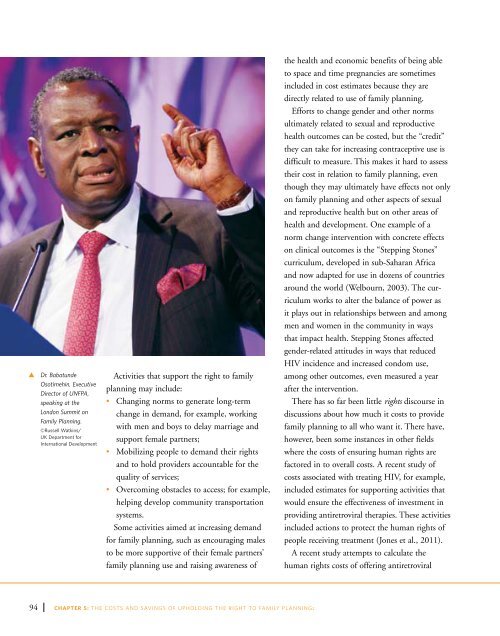State of World Population 2012 - Country Page List - UNFPA
State of World Population 2012 - Country Page List - UNFPA
State of World Population 2012 - Country Page List - UNFPA
You also want an ePaper? Increase the reach of your titles
YUMPU automatically turns print PDFs into web optimized ePapers that Google loves.
t<br />
Dr. Babatunde<br />
Osotimehin, Executive<br />
Director <strong>of</strong> <strong>UNFPA</strong>,<br />
speaking at the<br />
London Summit on<br />
Family Planning.<br />
©Russell Watkins/<br />
UK Department for<br />
International Development<br />
Activities that support the right to family<br />
planning may include:<br />
• Changing norms to generate long-term<br />
change in demand, for example, working<br />
with men and boys to delay marriage and<br />
support female partners;<br />
• Mobilizing people to demand their rights<br />
and to hold providers accountable for the<br />
quality <strong>of</strong> services;<br />
• Overcoming obstacles to access; for example,<br />
helping develop community transportation<br />
systems.<br />
Some activities aimed at increasing demand<br />
for family planning, such as encouraging males<br />
to be more supportive <strong>of</strong> their female partners’<br />
family planning use and raising awareness <strong>of</strong><br />
the health and economic benefits <strong>of</strong> being able<br />
to space and time pregnancies are sometimes<br />
included in cost estimates because they are<br />
directly related to use <strong>of</strong> family planning.<br />
Efforts to change gender and other norms<br />
ultimately related to sexual and reproductive<br />
health outcomes can be costed, but the “credit”<br />
they can take for increasing contraceptive use is<br />
difficult to measure. This makes it hard to assess<br />
their cost in relation to family planning, even<br />
though they may ultimately have effects not only<br />
on family planning and other aspects <strong>of</strong> sexual<br />
and reproductive health but on other areas <strong>of</strong><br />
health and development. One example <strong>of</strong> a<br />
norm change intervention with concrete effects<br />
on clinical outcomes is the “Stepping Stones”<br />
curriculum, developed in sub-Saharan Africa<br />
and now adapted for use in dozens <strong>of</strong> countries<br />
around the world (Welbourn, 2003). The curriculum<br />
works to alter the balance <strong>of</strong> power as<br />
it plays out in relationships between and among<br />
men and women in the community in ways<br />
that impact health. Stepping Stones affected<br />
gender-related attitudes in ways that reduced<br />
HIV incidence and increased condom use,<br />
among other outcomes, even measured a year<br />
after the intervention.<br />
There has so far been little rights discourse in<br />
discussions about how much it costs to provide<br />
family planning to all who want it. There have,<br />
however, been some instances in other fields<br />
where the costs <strong>of</strong> ensuring human rights are<br />
factored in to overall costs. A recent study <strong>of</strong><br />
costs associated with treating HIV, for example,<br />
included estimates for supporting activities that<br />
would ensure the effectiveness <strong>of</strong> investment in<br />
providing antiretroviral therapies. These activities<br />
included actions to protect the human rights <strong>of</strong><br />
people receiving treatment (Jones et al., 2011).<br />
A recent study attempts to calculate the<br />
human rights costs <strong>of</strong> <strong>of</strong>fering antiretroviral<br />
94 CHAPTER 5: THE COSTS AND SAVINGS OF UPHOLDING THE RIGHT TO FAMILY PLANNING:
















